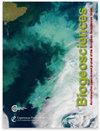Herbivore–shrub interactions influence ecosystem respiration and biogenic volatile organic compound composition in the subarctic
IF 3.9
2区 地球科学
Q1 ECOLOGY
引用次数: 0
Abstract
Abstract. Arctic ecosystems are warming nearly 4 times faster than the global average, which is resulting in plant community shifts and subsequent changes in biogeochemical processes such as gaseous fluxes. Additionally, herbivores shape plant communities and thereby may alter the magnitude and composition of ecosystem respiration and biogenic volatile organic compound (BVOC) emissions. Here we determine the effect of large mammalian herbivores on ecosystem respiration and BVOC emissions in two southern and two northern sites in Swedish Scandes, encompassing mountain birch (LOMB) and shrub heath (LORI) communities in the south and low-herb meadow (RIGA) and shrub heath (RIRI) communities in the north. Herbivory significantly altered BVOC composition between sites and decreased ecosystem respiration at RIGA. The difference in graminoid cover was found to have a large effect on ecosystem respiration between sites as RIGA, with the highest cover, had 35 % higher emissions than the next highest-emitting site (LOMB). Additionally, LOMB had the highest emissions of terpenes, with the northern sites having significantly lower emissions. Differences between sites were primarily due to differences in exclosure effects and soil temperature and the prevalence of different shrub growth forms. Our results suggest that herbivory has a significant effect on trace gas fluxes in a productive meadow community and that differences between communities may be driven by differences in shrub composition.草食-灌木相互作用影响亚北极生态系统呼吸和生物源性挥发性有机化合物组成
摘要北极生态系统的变暖速度比全球平均速度快近4倍,这导致了植物群落的变化以及随后的生物地球化学过程(如气体通量)的变化。此外,草食动物塑造植物群落,从而可能改变生态系统呼吸和生物源性挥发性有机化合物(BVOC)排放的大小和组成。本研究确定了大型食草动物对瑞典斯堪的纳维亚南部和北部两个地点的生态系统呼吸和BVOC排放的影响,包括南部的山地桦树(LOMB)和灌木石南(LORI)群落和北部的低草本草甸(RIGA)和灌木石南(RIRI)群落。草食显著改变了试验点间BVOC的组成,降低了生态系统呼吸。禾草类覆盖的差异对不同地点之间的生态系统呼吸有很大的影响,覆盖最高的里加的排放量比第二高的排放地点(LOMB)高35%。此外,LOMB的萜烯排放量最高,而北部的排放量明显较低。不同立地间的差异主要是由于围封效果和土壤温度的差异以及不同灌木生长形式的流行程度。结果表明,草食对草甸群落微量气体通量有显著影响,群落间的差异可能是由灌木组成的差异造成的。
本文章由计算机程序翻译,如有差异,请以英文原文为准。
求助全文
约1分钟内获得全文
求助全文
来源期刊

Biogeosciences
环境科学-地球科学综合
CiteScore
8.60
自引率
8.20%
发文量
258
审稿时长
4.2 months
期刊介绍:
Biogeosciences (BG) is an international scientific journal dedicated to the publication and discussion of research articles, short communications and review papers on all aspects of the interactions between the biological, chemical and physical processes in terrestrial or extraterrestrial life with the geosphere, hydrosphere and atmosphere. The objective of the journal is to cut across the boundaries of established sciences and achieve an interdisciplinary view of these interactions. Experimental, conceptual and modelling approaches are welcome.
 求助内容:
求助内容: 应助结果提醒方式:
应助结果提醒方式:


